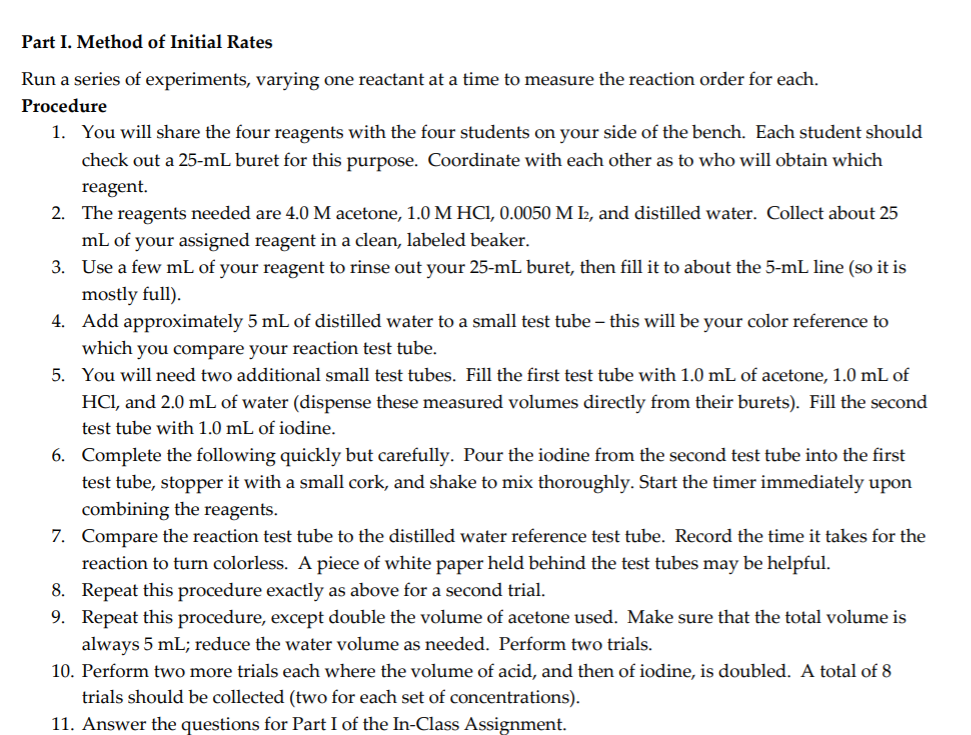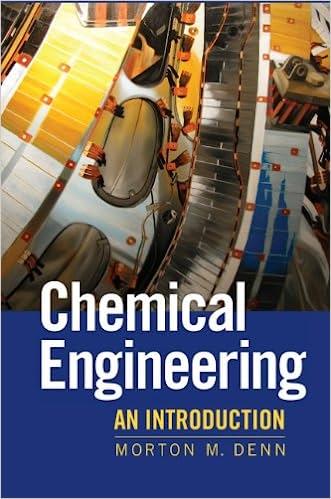Please answer both questions 3 and 5:



Part I. Method of Initial Rates Run a series of experiments, varying one reactant at a time to measure the reaction order for each. Procedure 1. You will share the four reagents with the four students on your side of the bench. Each student should check out a 25-mL buret for this purpose. Coordinate with each other as to who will obtain which reagent 2. The reagents needed are 4.0 M acetone, 1.0 MHCI, 0.0050 M 12, and distilled water. Collect about 25 mL of your assigned reagent in a clean, labeled beaker. 3. Use a few mL of your reagent to rinse out your 25-ml buret, then fill it to about the 5-mL line (so it is mostly full). 4. Add approximately 5 mL of distilled water to a small test tube - this will be your color reference to which you compare your reaction test tube. 5. You will need two additional small test tubes. Fill the first test tube with 1.0 mL of acetone, 1.0 mL of HCl, and 2.0 mL of water (dispense these measured volumes directly from their burets). Fill the second test tube with 1.0 mL of iodine. 6. Complete the following quickly but carefully. Pour the iodine from the second test tube into the first test tube, stopper it with a small cork, and shake to mix thoroughly. Start the timer immediately upon combining the reagents. 7. Compare the reaction test tube to the distilled water reference test tube. Record the time it takes for the reaction to turn colorless. A piece of white paper held behind the test tubes may be helpful. 8. Repeat this procedure exactly as above for a second trial. 9. Repeat this procedure, except double the volume of acetone used. Make sure that the total volume is always 5 mL; reduce the water volume as needed. Perform two trials. 10. Perform two more trials each where the volume of acid, and then of iodine, is doubled. A total of 8 trials should be collected (two for each set of concentrations). 11. Answer the questions for Part I of the In-Class Assignment. QUESTION 3 In Trial 3, the concentration of acetone is doubled, while the concentration of iodine is kept constant. Suppose that Trial 3 takes only 37 seconds. Calculate the reaction rate. Round your answer to two sig figs, use scientific notation, and include units. For example, an answer could look like: 5.0E-6 M/S QUESTION 5 2 points Save Answer The previous question provides us with a quantitative way to determine the rate order from our data. In this problem, think more qualitatively about how rate order affects reaction rate and also reaction time. Suppose that the baseline Trial 1 takes 2 minutes and 30 seconds. How long would you expect the reaction in Trial 5 to take if it turns out that HCl is zero-order? What if, instead, it is first-order? See the Procedure; Trial 5 uses double the concentration of HCI. For the toolbar, press ALT+F10 (PC) or ALT+FN+F10 (Mac). Paragraph Open Sans,sa... 10pt A Ix H Q 6 liil x2 X2 i > Ils + JC T " 12 E i {;}









